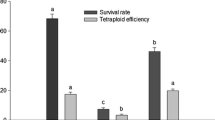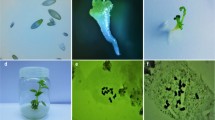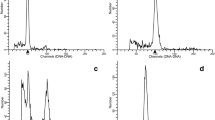Abstract
A potato breeding scheme implies the possibility of ploidy level manipulation either by reducing the chromosome number of cultivars from 48 to 24 to be able to cross them with diploid related species or by doubling diploid material to reach the generally optimal tetraploid level. In vitro spontaneous chromosome doubling is widely used but can lead to somaclonal variation. Since oryzalin has proven to be efficient as a chromosome doubling agent on potato cell suspension cultures, we tried this herbicide on various Solanum species and interspecific diploid hybrids. A 24 h dip in a 28.8 μM aqueous oryzalin solution applied on apical buds was the most efficient treatment in terms of tetraploid plant production (mean = 4.1 tetraploid plants for 10 treated buds over 4 genotypes). However 50–100% of the regenerated tetraploid plants acclimatized after in vitro treatment proved to be chimaeric. Consequently, a selection procedure in the progeny was necessary to obtain real and stable doubled clones and final yields were low. This technique is easy to apply and could be a good alternative to chromosome doubling by spontaneous in vitro regeneration in the case of refractory genotypes especially where somaclonal variation is problematic. Percentage of tetraploids among the regenerated plants varied from 6 to 29% with the oryzalin doubling technique while it varied from 20 to 78% by in vitro spontaneous doubling for five diploid genotypes. An observation of the progeny indicated that chimaeras were more frequent using oryzalin (50–100% of the initially supposed tetraploid plants) than when chromosomes doubled spontaneously (4–67% of the initially supposed tetraploid plants).
Similar content being viewed by others
References
Brown SC, Bergounioux C, Tallet S & Marie D (1991) Flow cytometry of nuclei for ploidy and cell cycle analysis. In: Negrutiu I & Gharti-Chhetri G (eds) A Laboratory Guide For ¨ Cellular and Molecular Plant Biology (pp. 326-345). Bikhauser, Basel
Cardi T, Carputo D & Frusciante L (1992) In vitro shoot regenera-tion and chromosome doubling in 2x and 3x potato clones. Am. Potato J. 69: 1-12
Cardi T, Iannamico V, Dambrosio F, Filippone E & Lurquin PF (1993) In vitro regeneration and cytological characterization of shoots from leaf explants of 3 accessions of Solanum comme-sonii. Plant Cell Tiss. Org. Cult. 34: 107-114
de Maine MJ & Fantes JA (1983) The results of colchicine treatment of dihaploids and their implications regarding ef-ficiency of chromosome doubling and potato histogeny. Potato Res. 26: 289-294
de Maine MJ & Simpson G (1999) Somatic chromosome number doubling of selected potato genotypes using callus culture of the colchicine treatment of shoot nodes in vitro. Ann. Appl. Biol. 134: 125-130
Fleming ML, de Maine MJ & Powell W(1992) Ploidy doubling by callus culture of potato dihaploid leaf explants and the variation in regenerated plants. Ann. Appl. Biol. 121: 183-188
Hermsen JGT, Ramanna MS, Roest S & Bokelmann GS (1981) Chromosome doubling through adventitious shoot formation on in vitro cultivated leaf explants from diploid interspecific potato hybrids. Euphytica 30: 239-246
Jacobsen E (1977) Doubling dihaploid potato clones via leaf tissue culture. Z. Pflanzenzuechtung 80: 80-82
Jacobsen E (1981) Polyploidization in leaf callus tissue and in regenerated plants of dihaploid potato. Plant Cell Tiss. Org. Cult. 1: 77-84
Karp A, Risiott R, Jones MGK & Bright SWJ (1984) Chromosome doubling in monohaploid and dihaploid potatoes by regeneration from cultured leaf explants. Plant Cell Tiss. Org. Cult. 3: 363-373
Langton FA (1974) A re-evaluation of the Dionne method of vegetatively doubling the chromosome number in potato. Potato Res. 17: 296-306
Morejohn LC, Bureau TE, Mole-Bajer J, Bajer AS & Fosket DE (1987) Oryzalin, a dinitroaniline herbicide, binds to plant tubulin and inhibits microtubule polymerization in vitro. Planta 172: 252-264
Mozafari J, Wolyn DJ & Alikhan ST (1997) Chromosome doubling via tuber disc culture in dihaploid potato as determined by confocal microscopy. Plant Cell Rep. 16: 329-333
Mribu HK & Veilleux RE (1990) Effect of genotype, explant, subculture interval and environmental conditions on regeneration of shoots from in vitro monoploids of a diploid potato species, Solanum phureja Juz and Buk - Factors affecting shoot regene-ration of monoploid potato. Plant Cell Tiss. Org. Cult. 23: 171-179
Ortiz R (1998) Potato Breeding via ploidy manipulations. Plant Breeding Rev. 16: 15-86
Ramulu KS, Verhoeven HA & Dijkhuis P (1991) Mitotic blocking, micronucleation, and chromosome doubling by oryzalin, amip-rophos-methyl, and colchicine in potato. Protoplasma 160: 65-71
Roest S & Bokelmann GS (1976) Vegetative propagation of Solanum tuberosum L. in vitro. Potato Res. 19: 173-178
Ross RW, Dionne LA & Hougas RW(1967) Doubling the chromo-some number of selected Solanum genotypes. Eur. Potato J. 10: 37-52
Rousselle-Bourgeois F & Rousselle P (1996) Amelioration genetique. In: Rousselle P, Robert Y & Crosnier JC (eds) La Pomme de Terre (pp 125-154). INRA Editions, Paris
Sonnino A, Iwanaga M & Henostroza A (1988) Chromosome doubling of 2x potato lines with diverse genetic background through tissue culture. Potato Res. 31: 627-631
Tendille C & Lecerf M (1974) La multiplication vegetative de l'asperge (Asparagus officinalis L.). Action de divers facteurs, en particulier de la nutrition minérale, sur le développement de méristèmes d'asperge, sur la croissance des plantules issues de ces méristémes et sur la production de plantes adultes. Ann. Amelioration Plantes 24: 269-282
Vannini GL & Poli F (1983) Binucleation and abnormal chromo-some distribution in Euglena gracilis cells treated with dimethyl sulphoxide. Protoplasma 114: 62-66
Author information
Authors and Affiliations
Corresponding author
Rights and permissions
About this article
Cite this article
Chauvin, J., Souchet, C., Dantec, J. et al. Chromosome doubling of 2x Solanum species by oryzalin: method development and comparison with spontaneous chromosome doubling in vitro . Plant Cell, Tissue and Organ Culture 73, 65–73 (2003). https://doi.org/10.1023/A:1022663816052
Issue Date:
DOI: https://doi.org/10.1023/A:1022663816052




